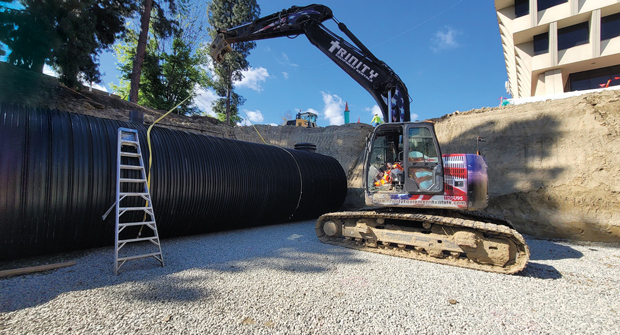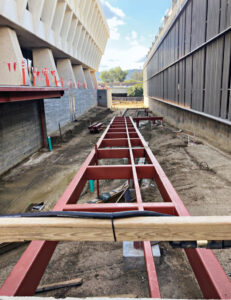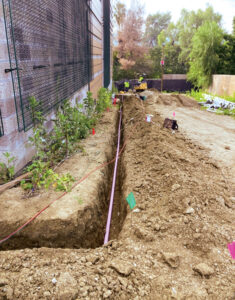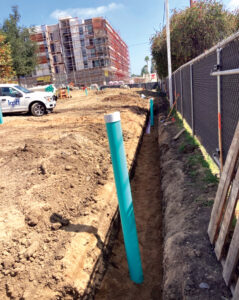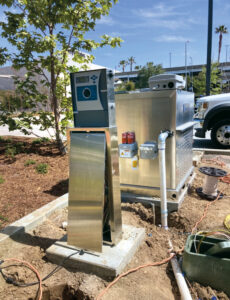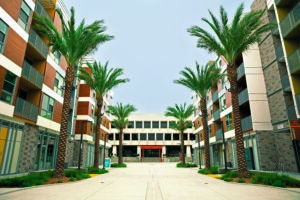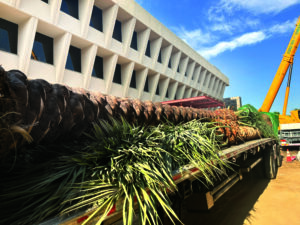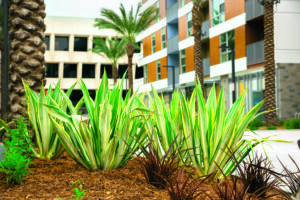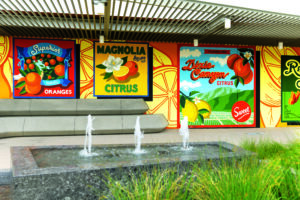It’s not unusual for landscapers to develop at least some personal attachment to the properties that they help design, construct or maintain.
For Robert Olsen, the CEO of Goldenstate Landscapes in Camarillo, Calif., his connection to the new Citrus Commons project in nearby Sherman Oaks — on a site that served as the former headquarters of Sunkist — runs a little deeper than most.
“Yeah, that one is personal for me,” Olsen admits. “I grew up on a citrus farm, and my family were growers for Sunkist. I grew up going to Sunkist packing houses and things like that.
“After I founded Goldenstate, I actually tried to get the maintenance work at the Sunkist headquarters when it was still there, largely for sentimental reasons. But I could never get the former property manager to give me the time of day.”
But good things come to those who wait. When IMT Residential acquired the property and began to work on an innovative redevelopment that includes both residential and commercial elements, Olsen and Goldenstate landed the job to construct and maintain many of the project’s landscaped areas and the irrigation system.
So not only did the job give Olsen a chance to bring his green industry journey full circle, it also gave the team at Goldenstate the chance to prove that it could successfully manage, complete and maintain a major project, the largest the company had ever attempted.
“While there was nothing on this project that we hadn’t done before, the scope was just so much bigger. It was the largest single contract the company has ever done. And from top to bottom, our team stepped up and delivered,” Olsen says. “We’re not one of the big, giant companies that usually get these kinds of projects. But I think we made a bit of a statement about what we could do and what we’re capable of.”
Sunset and sunrise
Sunkist’s original headquarters building was constructed in 1970. Designed by Los Angeles architect group A.C. Martin and Associates, the building is a Southern California landmark and a textbook example of brutalist architecture, featuring recessed windows and a reinforced concrete structure in an inverted pyramid style that resembled crates used to transport citrus (which was more by coincidence than design).
But notoriety doesn’t always translate into modern functionality, and by 2014, the company was ready for a new home. In August of that year, it moved its headquarters to Valencia on the northern edge of Los Angeles. At about the same time, IMT Residential purchased the original building and surrounding property with designs on turning it into an 8 1/2-acre mixed-use showpiece.
It would take some time for those plans to become a reality as the developer, the city and citizens sparred over the details of the project. There were concerns about the fate of the Sunkist building — the plan was always to renovate it and keep it as office space at the centerpiece of the new development — the size and scope of both the residential and commercial build, the number of parking spaces allotted for the project and everything in between.
As those discussions continued, IMT made that long-awaited call to Olsen and Goldenstate, and the company began to provide regular maintenance work on the existing landscaping and irrigation. And when IMT finally got clearance in 2021 to start work on what by then had been dubbed Citrus Commons, Goldenstate was one of the first companies it brought in to work on the project.
“We had been working with IMT on other projects, in addition to doing the maintenance on this property,” Olsen says. “I had mentioned to them all along that we would really like to be a part of this project once they got the green light, so that was always the goal. It was exciting to get the opportunity to keep working there and be a part of transforming it into what it is today.”
Rookie of the year
Goldenstate was one of several subcontractors that IMT brought on to contribute to various aspects of Citrus Commons. For the landscape design portion of the project, IMT turned to Border, an LA-based design firm led by Duane Border. The plans it developed included a redesign of an open-air atrium in the Sunkist building, original designs for the residential gardens and all green spaces in and around the new buildings, as well as landscape designs on the perimeter of the property.
Goldenstate worked hand-in-hand with Border to make sure the design’s vision became a reality. And from the very first preconstruction meeting, Olsen knew this would be a different project than any he and his company had been a part of before.
“It was a very hands-on process, more than any other we’d be involved in, but in a good way,” Olsen says. “All the plant material that we purchased had to be approved beforehand … so we worked closely with Duane and his team to review all of that.
There was a lot of physical tagging of trees at nurseries for quality control — just much more hands-on involvement than we were used to.
“That said, we knew all that going in. We knew what the internal system was going to look like, how we were going to communicate with everyone involved. It wasn’t a surprise, and it ended up working out pretty well.”
Citrus Commons was the first project that Border had worked on with Goldenstate, but any concerns that the size and scope of the work required would overwhelm Olsen and his team were eased at those very first meetings.

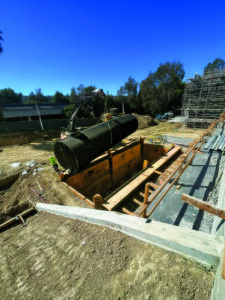
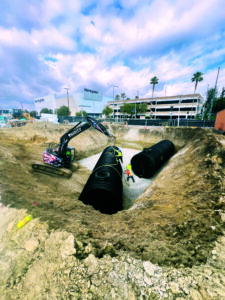
“There were plenty of special conditions with this project, from requirements that 75 percent of the landscaping had to be native to the irrigation and water management,” Border says. “We wanted to be sure that whoever came on to the project could source the materials needed, install it all and maintain it. And Robert and his team never flinched. It was a great partnership.”
The landscaping side of Goldenstate’s work involved primarily native plants, trees and shrubs, Olsen says.
“There are hundreds of trees on the site — sycamores, oaks, date palm trees,” he explains. “The large majority of the plant and shrub materials that we used were native, and most of the trees are, too. Date palms aren’t necessarily native, but they did fit in naturally with everything else that was in the plan.”
But as interesting and unique as the landscaping work that took place above ground was, it’s what’s underground — the irrigation and water management tools that keep that landscaping thriving in the challenging climes of Southern California — that took Olsen and his Goldenstate teammates into a brave, new world.
Making water work
Innovative water management products and cutting-edge irrigation practices are nothing new to the teams at Goldenstate and Border. But in the Citrus Commons project, those techniques would be put to the test, thanks to the collision of the project’s size and scope and because of California’s specific regulations when it comes to water use.
As Border explains, “All of the irrigation design and calculations associated with it have to be done in conjunction with California AB 1881, which is essentially about maximum allowed water use. You have to design to those standards, to make plant selections based on that, everything. We knew this project would already be water conscious with all the native and indigenous plants, but it was still a huge consideration.”
At Citrus Commons, what that resulted in was a recycled water plan anchored by a series of large underground storage tanks that collect runoff from the entire property. That water is then filtered and sent back to the landscaping through a system that relies almost exclusively on drip irrigation heads for final delivery.
The storage units sit below what is now the parking lot for a Trader Joe’s that is a part of the project’s commercial development. In the landscape design, most planting areas were strategically distributed to maximize their ability to absorb runoff before that water reached the storage tanks. Water that makes its way to the tanks is then treated and recycled before the process starts all over again.
“Anything and everything that hits a hard surface — from the rooftops on the buildings all the way down to the driveways, the plazas, the walkways — makes its way either directly into the plantings or into the tanks for filtration and then distribution,” Border says.
And when Mother Nature doesn’t deliver enough rainfall, the system can be triggered to access city water to make up the difference. The hope, both Olsen and Border say, is that those instances are few and far between.
“Recycled water and drip irrigation … are becoming almost common in California, so we’re used to working with both,” Olsen says. “But we’d never worked on anything this big before. The ability to scale up those concepts so that they made sense at something the size of Citrus Commons was pretty impressive.”
Fantastic finish
At each step along the way — from ongoing maintenance and plant selection to landscape installation and fine-tuning of the irrigation system — Olsen and his team viewed the Citrus Commons job as a chance to demonstrate their ability to manage any project, large or small.
Border considers that mission accomplished. “After our experience on this project, I told Robert that Goldenstate is now on our list. Any other commercial projects that come our way, they’ll be at the top of the list of recommendations we make to the developer, because they did an incredible job.”
Those words are music to Olsen’s ears. And it’s something he says he was able to fully appreciate during Citrus Commons’ official grand opening in June (even though work to renovate the interior of the Sunkist Building continues).
“I had a rare moment during the grand opening where I was able to take everything in and see what we’d accomplished,” Olsen says. “You’re always caught up in solving problems or trying to see what possible pitfalls might be coming while you’re working on the project that you don’t always step back and take pride in what’s been done, and I was able to do that for a little bit.
“I was just grateful that IMT gave us a shot, Duane gave us a shot, and we were able to show that, hey, we can do this kind of work.”
